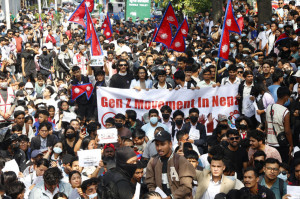Editorial
Hazy times
Alternative management of stubbles should be incentivised and practitioners of stubble-burning punished.
An unseasonal grey haze shrouds the sky, a burning sensation pricks the eyes, and a faint headache lingers. A big autumn festival is just over, and many more are on the way, but the mood outside is sombre at best. The fossil fuel-guzzling vehicles have returned to the roads after the brief Dashain lull, and the carbon monoxide levels in the cities have spiked. If that was not enough, farmers have returned to the fields for the seasonal harvest, and smoke billowing from farms has returned to the sky. It is the story of poor accountability on the part of the government and lack of innovation on the part of the farmers repeated all over again. As in last year, people’s quality of life has gone for a toss as the government pays little heed to the annual ritual of stubble burning after paddy harvest and farmers have discovered no alternative to this unscientific practice that puts the lives of their fellow citizens, and their own, at risk.
Making things worse are the big chunks of smoky clouds that float freely across our skies, irrespective of man-made national boundaries. Stubble-burning in the northern Indian states of Punjab, Uttar Pradesh, Haryana and Bihar pass noxious fumes air to Nepali skies, adding to the hazard we already face from the toxicity we are generating at home. Punjab recorded a 63 percent year-on-year growth in farm fire incidences in October. With mechanised harvesting techniques becoming mainstream in agriculture-dominant states like Punjab, the burning of farm residues is expected to rise further in the years ahead. And despite state governments committing to control the practice, there has been little cooperation from the farmers in lieu of viable support plans. What’s more, farmers are increasingly burning farm residues including stalks and leaves of paddy, wheat and sugarcane plants.
As in northern India, stubble burning is becoming mainstream in Nepal, particularly in the Tarai belt. The practice is certain to expand across the country as farmers adopt it without heeding the consequences. And with the government looking the other way, there is no stopping its spread while the health of humans and the environment continues to deteriorate. In a country that sees the deaths of 40,000 people from particulate matter pollution each year, in addition to 34,000 deaths due to smoking, the rise in stubble burning is certain to add to the death count in the long run, apart from posing some immediate health issues.
The government can intervene through a two-pronged approach: Incentivising alternative management of stubbles, and punishing the practitioners of stubble-burning. Research shows there are benefits to incorporating stubble into the soil, using it as raw material for pulp and paper industries and biofuel production, among others. With proper guidance and sensitisation, it shouldn’t be that hard to convince the farmers to adopt these alternative methods of stubble management that are more beneficial than burning. If convincing doesn’t work, the government must take the next logical step of strictly enforcing the law against polluting the environment.




 22.12°C Kathmandu
22.12°C Kathmandu














